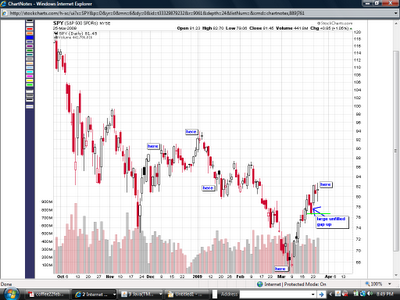 Click On Chart to Enlarge
Click On Chart to Enlarge
I started this blog in early April of last year because it was apparent in January of 2008 that the 2002-2007 bull market was over and that this bear market could be a severe one. I wanted to give friends and family a chance to take control of their investments to some degree, seeing as the largest segment of our population is hitting retirement age. Could there be a worse time for such a bad bear market?
Despite the horrible buy and hold performance for stocks since the bear market began, the huge increase in volatility has provided the short-term trader with almost the best possible environment to make money. Also, the advent of inverse ETFs has made it easily accessible for the retail trader to profit during market declines.
On account of the one year blogiversary and the end of the first quarter, I wanted to give a trade review and discuss some simple money management ideas for how to fit the blog trades into an investment strategy. The first quarter trades provided excellent results with a current string of 6 winning trades to only one small loss.
The chart above shows only the 2009 blog trades. I posted the 2008 trade review in January. Most of the info is self explanatory, but I wanted to explain some things so that interpretation of the results is easy.
The "Stop?" column shows a star if the trade was exited with a stop loss as opposed to the typical indicator signal. I have explained before that I don't typically recommend stops for these trade because it theoretically hurts the performance of a mean-reverting system.
The "$10,000 Per Trade" column under "2009" show the running total of profits from trades so far this year if devoting exactly $10,000 to each recommendation.
The "$10,000 Cumulative" column under "2009" shows the running account value with the intial $10,000 included if the entire account value was devoted to each trade. This allows a compounding effect.
The next 2 columns are the exact same thing except that it includes all the 2008 short-term trades as well which are represented by the purple font beginning value in those columns.
What you can see is that starting with $10,000 on the first blog trade in April of last year, and using the cumulative strategy, the account value would have more than tripled, gaining over 200%. No commisions, etc. are taken into account, but that wouldn't change things much. The only change in real life implementation of that strategy is that the first BGZ trade this year overlapped the following SDS trade. That would decrease the return a little. Otherwise, the trades are all non-overlapping and could realistically be traded in the "cumulative" fashion.
If simply devoting $10,000 to each trade since the first blog trade in 2008 the profits would be over $17,000 as of today's closed trade.
Those two strategies are really what I had in mind for blog followers when I started the blog, and they are still the two ways I would recommend approaching blog trades from a money management perspective. That is either....
1) Decide on an initial amount to devote to these trades and treat it like its own account continually devoting all profits (or losses) to the next trade to create a powerful compounding effect.
2) Make a fixed $ investment in every trade.
I think strategy #1 makes sense for a beginning trader or a small account size to try to increase account value. I think strategy #2 is more realistic for a large account size and is a more "business-like" approach.
Hopefully this post was somewhat helpful and not just a boring read. It shows the power of a solid system with the inherent leverage of the ultra ETFs. I suppose you could take the idea further and propose using 3x ETFs for all trades or deep ITM options, but in the event of a very bad trade for whatever reason, that could result in an undesirably large drawdown in account value. I believe the 2x ETFs can be traded in the cumulative manner using this blog without much worries of any type of crippling drawdown.
Tomorrow I will again touch on the topic of what kind of price action is needed to confirm when the bear market is over. I know that many hope it is over already, but, in short, at this point I would advise extreme caution in that regard.
Pete
 Click on Chart to Enlarge
Click on Chart to Enlarge


















